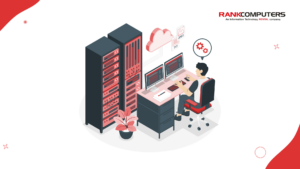Until not long ago, I had my doubts about servers. I used to get confused and had it all mixed up. If you find yourself in a similar situation and are at level one, then this article is just for you! By the end of this article, you’ll hopefully be a step or two ahead of your previous self. So to begin with, I’ll start with the basic question: What are servers?
Simply put in the easiest of words, servers are just really big and powerful computers with additional RAMs and cards and stuff. But they aren’t like the ones you’d be using right now to read this article. It doesn’t have a keyboard or a screen or a mouse. Just big powerful CPUs. Let’s take an analogy with respect to your regular computer or laptop. The way your computer stores your data and files on itself, a server stores all the data associated with the websites that are hosted by it and shares that information with all computers and mobile devices (like your laptop, in this case) that need to access them.
Think of Airbnb. Let’s say you want to book a hotel in Paris. But in order to book a hotel there, you’ll have to go through something which holds information about hotels in Paris; Airbnb. So, Airbnb will give you information regarding your hotel and connect you to it. Your URL or website (data) that you require is your hotel and the server which connects you, or brings you the required information, is Airbnb in our taken example.
When you type in a URL in your browser, your computer communicates with the server hosting the site and pulls out the requisite data on your computer.
You wouldn’t usually find servers lying around in someone’s house. Servers are usually present in business environments or offices where huge data handling is to be managed.
The above model is called the client-server model, where your computer (also called the client) is connected to the server and seeks various functionalities known as Services. Services include sharing data or resources among multiple computers (clients) or performing computations for a client.
A single server can serve multiple clients, and a client can connect to multiple servers. Simple thing: many people might be searching for the same hotel on Airbnb. It is also possible that the same hotel is registered on Trivago, along with Airbnb.
A few typical types of servers include:
- File Servers:
As the name suggests, any user connected to this server network can store files on this server.
2. Game Servers:
Game servers are used by game clients to play multiplayer games. The server transmits enough data about its internal state to allow its connected clients to maintain their own accurate version of the game world for a display to players.
3. Database Servers:
Simply said, these servers process database queries.
4. Web Servers:
These are the hidden heroes which help you connect to Wikipedia for that one assignment you’ve been racking your brains upon. Web servers deliver web pages. Every web server has an IP address and possibly a domain name.
5. Print Servers:
This server manages one or more printers.
6. Application Servers:
This is a complex server. It is a program that handles all application operations between users and a business’s databases. It is used to handle complex transaction-based applications.
7. Proxy Servers:
A proxy server sits between a client application, such as a webpage and a real server. They are used to improve performance and filter requests.
8. Cloud Servers:
Cloud servers are powerful physical or virtual servers that perform application and information-processing storage. Cloud servers are created using virtualization software to divide a physical server into multiple virtual servers. These are widely used nowadays due to many reasons:
- Cost-effective- Users only pay for what they need and reduce the expense that comes with maintaining the server hardware.
- Scalability- Users can scale computing and storage resources to meet changing needs. This is particularly helpful for organizations with fluctuating needs.
- Integration- An organization’s cloud servers are networked to ensure uninterrupted communication and fast deployment.
So these were the basics of servers, and I’m pretty sure you have a clearer idea about servers. Perhaps you might need a server for your new start-up and don’t want to invest much in buying one. Head on to Rank Computers to check on our site for something new! Hope this article turned out to be useful to you. You are now at level two in Server knowledge!
Aditya Khedulkar



